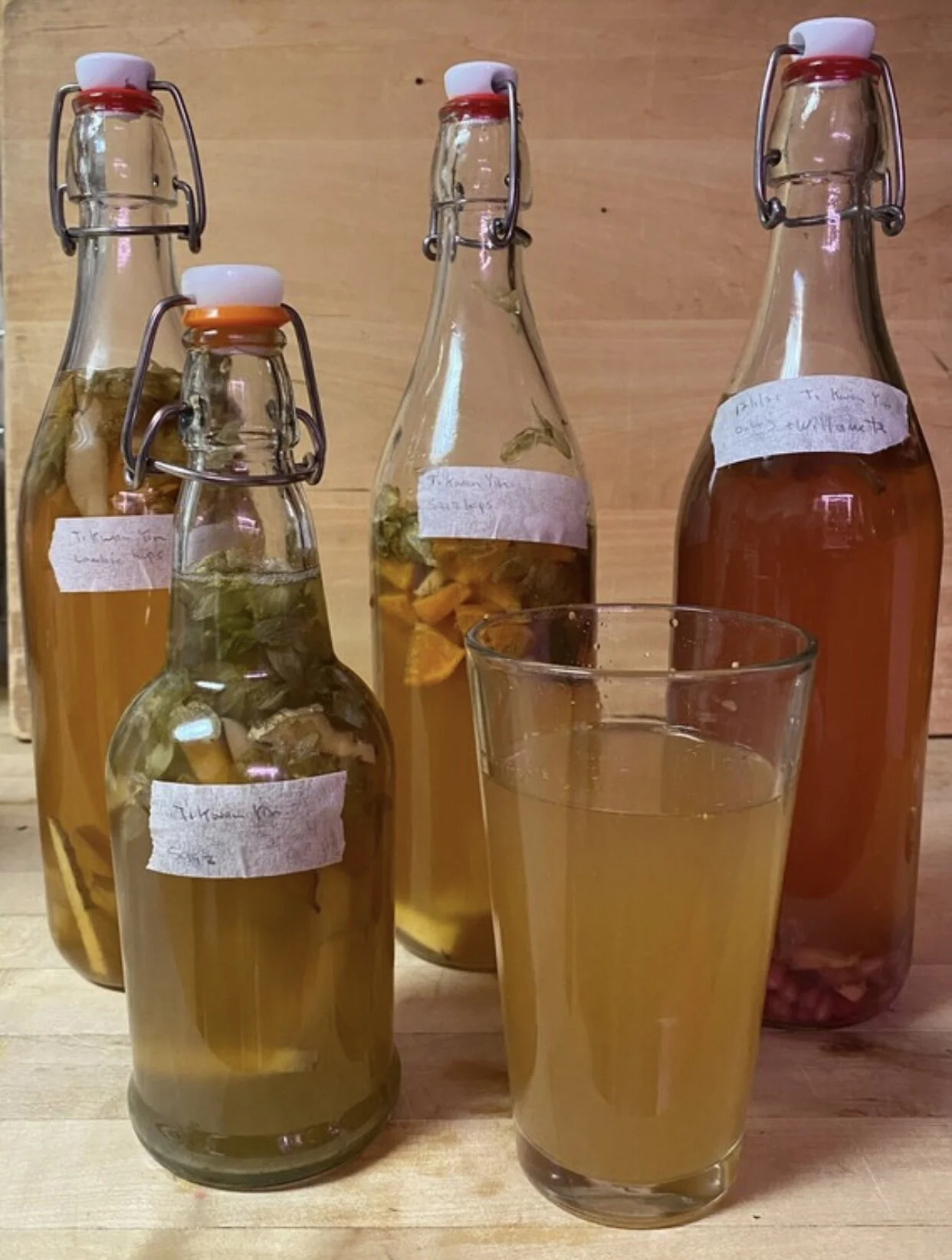How to Make Kombucha
Kombucha is rich in the probiotics that help keep our gut flora functioning properly and also supports our immune system. It contains live, beneficial bacteria and yeasts, antioxidants, B vitamins, and organic acids. Flavoring your kombucha with fruits, vegetables, juices, and herbs may contribute nutrients as well. Research suggests that drinking kombucha daily may further benefit our health by lowering cholesterol levels, aiding digestion, and improving liver and gastrointestinal functions.
Making kombucha at home can be more cost-effective than buying commercial kombucha and gives you the opportunity to choose the quality and types of ingredients that are important to you.
Instructions
Supplies
1 Cup of Organic Sugar
1 Gallon of Filtered Water (try your best to source water that does not contain microplastics, chemicals, pesticides, or heavy metals)
1 Scoby
Organic Green Tea or Black Tea - Your tea should be a high quality green tea or black tea. These are the ones I usually use:
Fermenting Glassware - North Mountain Supply 1 Gallon Glass Jar Wide Mouth with Grommeted Black Plastic Lid, and 2-Piece Airlock - USDA, BPA-Free, Made in the USA - https://a.co/d/3N0uP0L
Kombucha Bottles - EZ Cap brand Flip-Top bottles have a thick glass design and sturdy swing top making them one of the strongest on the market at handling carbonated beverages. 12 Pack, 33 oz (1 Liter) Swing Top Glass Bottles with Airtight Stopper Lids – https://a.co/d/3MFz7Vq
Tea Bags - Finum Disposable Paper Tea Filter Bags for Loose Tea, Brown, Large, 100 Count https://a.co/d/10qbWov
Directions
I mix a cup of organic sugar into a gallon of filtered water and bring it to a boil. Regular refined sugar is fine. I’ve also used tap water and gotten good results. Once it is boiling turn off the heat. Put a fairly good amount of tea into the tea bag (five to seven tablespoons) and drop it into the hot water to brew. Let it rest and cool off until it is between 68 and 70 degrees.
The reason I use filtered water is due to the reports of chemicals, microplastics, residual pharmaceuticals, chlorine, chloramine, heavy metals, waterborne pathogens (viruses, bacteria, protozoan cysts), Rotavirus, Hepatitis A, Norovirus, Giardiasis, Cryptosporidium, E. Coli, Coliform, etc. I was hesitant to drink our well water, believing our city water was better quality until I compared the results of testing we had done on both. There are a lot of cost-effective and convenient options available for filtering and treatment.
It is important to maintain a clean and safe environment and practices to minimize the risk of contaminants such as mold or harmful bacteria which could cause illness. Sanitization is critical. Always wash your hands well and rinse with kombucha or vinegar before handling your scoby. Make sure the glassware is clean and sanitized. I once had a scoby go bad because I was not cleaning the glassware each time between ferments.
Gently place the scoby in the glass container with a cup of plain, unflavored kombucha from your last fermentation if you have some left. Add the brewed tea that has cooled off (but not the teabag), screw on the lid with the air vent, and aim to keep it around 68 to 72 degrees out of direct sunlight. Some fermentations finish in about a week where mine can sit for three or four weeks until it is done (our kitchen is typically cooler than 65 degrees in the winter months). There is a little bit of preference and guesswork until you figure out your fermentation length of time. You can also taste it for readiness with a spoon but careful to not go with the spoon from your mouth back to the fermenting kombucha it will cause human natural bacteria get into the fermentation.
Once done, I pour the kombucha into swing top bottles. Leave some headspace for fruit, juice, and ingredients. It is important to note that kombucha left at room temperature in the swing-top bottles could result in an accumulation of carbon dioxide in the bottle and a fierce explosion of the contents. Plan to refrigerate your bottles if it will not be consumed over the next 1 to 3 days. We once included banana pieces for flavoring in a swing-top bottle of kombucha and left it sitting on the counter for more than a week. The pressure inside of the bottle was so intense, banana kombucha sprayed all over the kitchen ceiling and walls. We were cleaning for hours.
flavor suggestions
Turmeric / lemon / ginger - 1/3 cup of lemon juice, 2 tablespoons of honey, 1/2” fresh ginger (in thin slices) per 12-16oz, 1/4 tsp turmeric per 12-16oz, and some strips of lemon peel
Lemon / orange / citra hops - 1/3 cup each of lemon and orange juice, strips of lemon and orange peel, one hop flower per 12-16 oz
Raspberry / lemon - 1/2 cup of raspberries, 1/3 cup of lemon juice, strips of lemon peel
Mixed berry - raspberry, blackberry, blueberry, a few pieces of lemon peel
Blueberry lemon ginger - heat lemon juice, honey, and 1/4” fresh ginger per 12-16oz then cool, blueberries, some lemon peel
Strawberry / ginger - slice up a handful of strawberries, slice a 1/2” piece of ginger
Hops - I buy my hops from Freshops and routinely use:
Citra Hops - https://freshops.com/product/citra-hops/
Lambic Hops - https://freshops.com/product/lambic-hops/
Willamette Hops - https://freshops.com/product/willamette-hop/
Centennial Hops - https://freshops.com/product/centennial-hop/
Crystal Hops - https://freshops.com/product/crystal-hop/
Saaz Hops - https://freshops.com/product/saaz-czech-hop/

